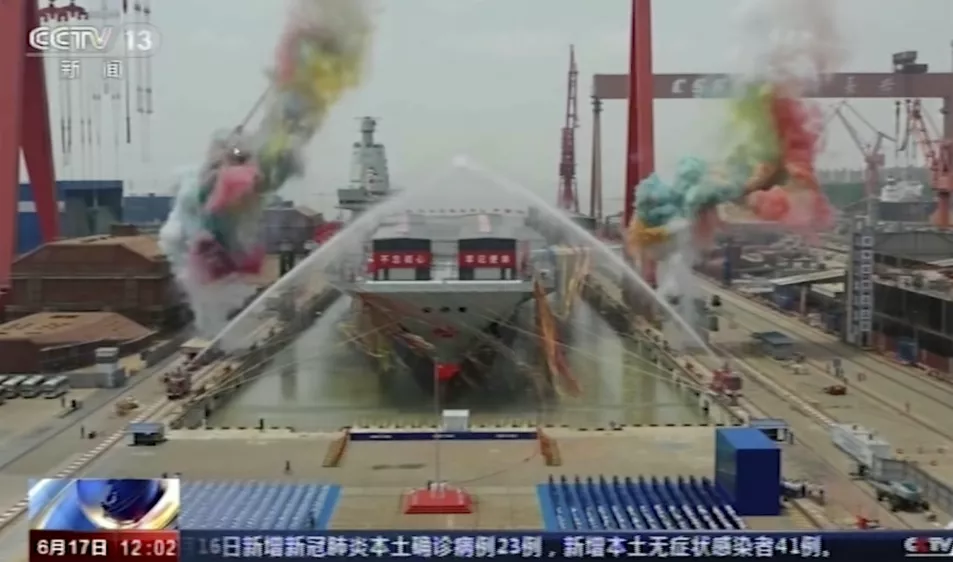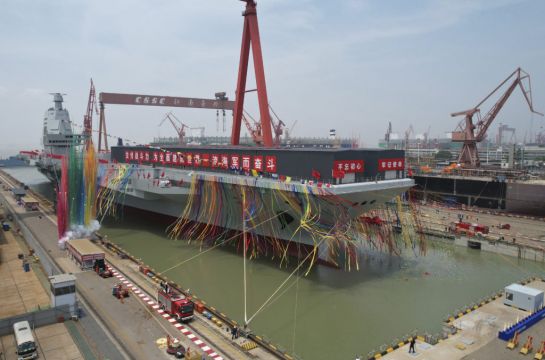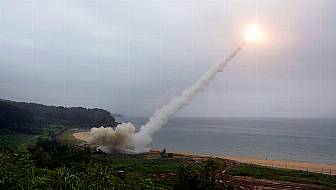Beijing launched a new-generation aircraft carrier on Friday, the first such ship to be both designed and built in China, in a milestone as it seeks to extend the range and power of its navy.
The Type 003 carrier named Fujian left its drydock at a shipyard outside Shanghai in the morning and tied up at a nearby pier, state media reports said.
State broadcaster CCTV showed assembled navy personnel standing beneath the massive ship as water jets sprayed over its deck, multi-coloured streamers flew and colourful smoke was released.
Equipped with the latest weaponry and aircraft-launch technology, the Type 003 ship’s capabilities are thought to rival those of Western carriers, as Beijing seeks to turn its navy, already the world’s largest, into a multi-carrier force.

Satellite imagery captured by Planet Labs PBC on Thursday and analysed by the Associated Press showed the carrier in what appeared to be a fully flooded drydock at the Jiangnan Shipyard, near Shanghai, ready for launch. It was draped with red bunting, presumably in preparation for the launch ceremony.
“This is an important milestone for China’s military-industrial complex,” said Ridzwan Rahmat, a Singapore-based analyst with the defence intelligence company Janes.
“This shows that Chinese engineers are now able to indigenously manufacture the full suite of surface combatants associated with modern naval warfare, including corvettes, frigates, destroyers, amphibious assault ships, and now an aircraft carrier,” he said.
“This ability to construct a very complex warship from the ground up will inevitably result in various spin-offs and benefits for the Chinese shipbuilding industry.”
China’s first carrier was a repurposed Soviet ship, and its second was built in China but based upon a Soviet design. Both were built to employ a so-called “ski-jump” launch method for aircraft, with a ramp at the end of the short runway to help planes take off.
The Type 003 employs a catapult launch, which experts had said appears to be an electromagnetic-type system like one originally developed by the US Navy.
China’s official Xinhua News Agency confirmed the Fujian employed the electromagnetic system in a report on Friday’s launch.
Such a system puts less stress on the aircraft than older steam-type catapult launch systems, and the use of a catapult means that the ship will be able to launch a broader variety of aircraft, which is necessary for China to be able to project naval power at a greater range, Mr Rahmat said.
“These catapults allow aircraft deployed to carry a more extensive load of weapons in addition to external fuel tanks,” he said.
“Once it is fully operational, (the Chinese navy’s) third carrier would also be able to deploy a more complete suite of aircraft associated with carrier strike group operations including carrier onboard delivery transport and airborne early warning and control airframes, such as the KJ-600.”

China’s People’s Liberation Army Navy (Plan) has been modernising for more than a decade to become more of a “blue water” force — one capable of operating globally rather than being restricted to remaining closer to the Chinese mainland.
At the same time, the US has been increasing its focus on the region, including the South China Sea. The vast maritime region has been tense because six governments claim all or part of the strategically vital waterway, through which an estimated five trillion US dollars (£4 trillion) in global trade travels each year and which holds rich but fast-declining fishing stocks and significant undersea oil and gas deposits.
China has been far and away the most aggressive in asserting its claim to virtually the entire waterway, its island features and resources.
The US Navy has sailed warships past artificial islands China built in the sea that are equipped with airstrips and other military facilities. China insists its territory extends to those islands, while the US Navy says it conducts the missions there to ensure the free flow of international trade.
In its report to the U.S. Congress last year on China’s military capabilities, the Department of Defence said the carrier development programme was critical to the Chinese navy’s continued development into a global force, “gradually extending its operational reach beyond East Asia into a sustained ability to operate at increasingly longer ranges.”
China’s “aircraft carriers and planned follow-on carriers, once operational, will extend air defence coverage beyond the range of coastal and shipboard missile systems and will enable task group operations at increasingly longer ranges,” the Defence Department said.
In recent years, China has expanded its presence into the Indian Ocean, the Western Pacific and beyond, setting up its first overseas base over the last decade in the African Horn nation of Djibouti, where the US, Japan and others also maintain a military presence.
It also recently signed a security agreement with the Solomon Islands that many fear could give it an outpost in the South Pacific, and is working with Cambodia on expanding a port facility there that could give it a presence in the Gulf of Thailand.
Xinhua reported the Fujian, which carries the hull number 18, had a fully loaded displacement of 72,000 tonnes. In a March report prepared by the US Congressional Research Service, however, analysts said that satellite images suggest the Type 003’s displacement was about 91,000 tonnes, similar to those of US Navy carriers.
The Plan currently has some 355 ships, including submarines, and the US estimates the force will grow to 420 ships by 2025 and 460 ships by 2030. Despite having the world’s largest navy numerically, however, the Plan for now still has nowhere near the capabilities of the US Navy and remains far behind in carriers.
The US Navy is the world’s leader in aircraft carriers, with 11 nuclear-powered vessels. It also has nine amphibious assault ships that can carry helicopters and vertical-takeoff fighter jets.
Britain and France also have their own carriers, and Japan has four “helicopter destroyers”, which are technically not aircraft carriers, but carry aircraft. Two are being converted to support short take-off and vertical-landing fighters.
China’s new carrier was named after the Fujian province on the country’s south-eastern coast, following a tradition after naming its first two carriers after the provinces of Liaoning and Shandong.







